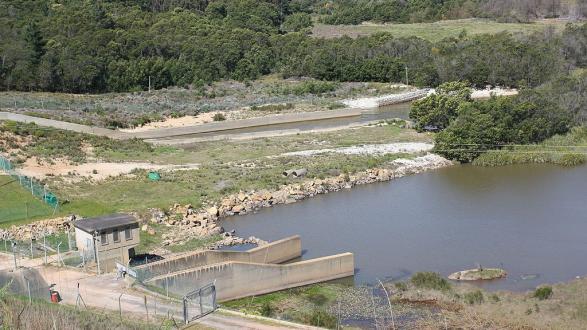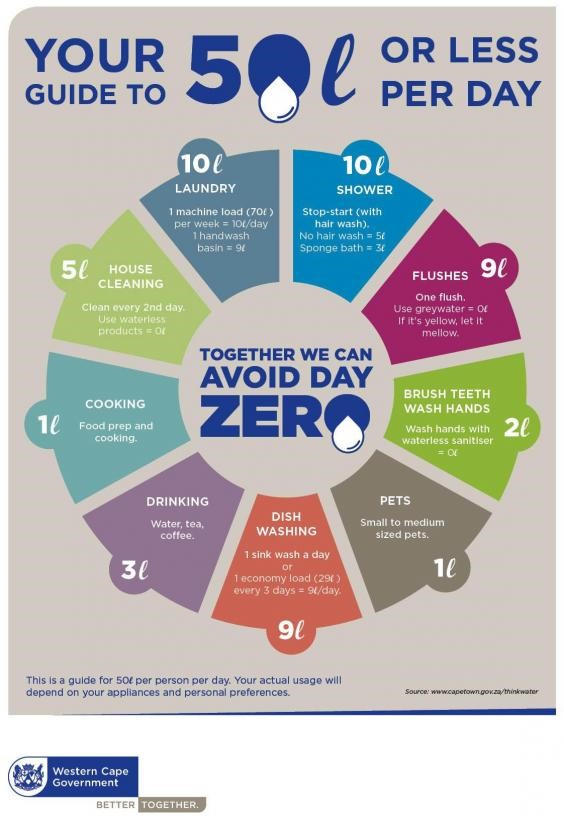Humans have been building cities for over 6,000 years, and we still don’t excel at it. Within those 6,000 years, the movement, storage, protection, and distribution of water have proven consistently difficult issues. This is especially pertinent for places that rely on surface water for their freshwater supply, and are therefore heavily dependent on rainfall. Enter Cape Town, South Africa, as it continues on its seemingly inexorable slide toward Day Zero, when taps to 1 million households—approximately 75 percent of the city’s total population of 4 million—will be shut off.
Capetonians have been asked to limit their consumption to 11 gallons (50 liters) per day, and Day Zero will reduce that allocation to just 6.6 gallons (25 liters). After Day Zero, citizens will collect water from 200 points throughout the city, each of which will serve 20,000 people. The logistics alone are anxiety-inducing.
On February 5, Cape Town officials pushed Day Zero back from April 16 to May 11 due to decreased agricultural water use. This doesn’t represent much of a reprieve for Cape Town: the city’s six reservoirs are at 26 percent capacity. Day Zero will kick in when they hit 13.5 percent. Keep in mind that the last 10 percent of water in the reservoirs isn’t useable, although Cape Town is installing special pipes to reduce that figure to 6 percent. One upside of pushing Day Zero to mid-May is that the rainy season may arrive by then, but if current meteorology is any indication, the rains are far from reliable.
Few would have predicted that Cape Town, long renowned for its sustainability practices, would end up where it is today.
Humans have not always failed at water and growth management. Edo, the Japanese capital from 1603 to 1868 and home to over 1 million people for at least part of that period, provided fresh water to all citizens 24 hours per day, regardless of class, via a network of underground bamboo pipes. Edo’s leaders keenly understood the relationship between upstream forests and the downstream water quality, and took deliberate steps to prevent erosion and protect watersheds through forestry policy. No European contemporary could match Edo’s aquatic achievements.
We’ve come a long way since Edo, but not always in the direction of progress. Like Cape Town, California has also been whiplashed by water, going from years of plentiful precipitation to drought. In 2015 and 2016, Californians cut water consumption significantly—by over 20 percent in many months. The governor lifted drought restrictions in early 2017, when snow pack in the Sierra Nevadas was 190 percent of normal. Snow pack this year is just 27 percent of normal. How different would California’s situation be had the water restrictions we saw during the summers of 2015 and 2016 stayed in effect, and had we continued to build water-smart policies and infrastructure out of a sense of climate-induced caution?
California’s previous five-year drought may be over, but the next one may make recent history look like a joke: the twentieth century was a particularly wet period in California’s history, and studies show the state has had 200-year mega-droughts at different points in the past. Similarly, Cape Town received record rainfall in 2014, and with storage full and consumption dropping due to conservation measures, the city delayed planning for future droughts. In 2015, it received the C40 network’s climate adaptation implementation prize. Few would have predicted that Cape Town, long renowned for its sustainability practices, would end up where it is today.
In California, as in Cape Town, good, wet years haven’t been enough to overcome the bad, dry ones.
Much of Cape Town’s growth over the past two decades occurred in informal settlements that consume much less water than wealthier areas, and water consumption per capita actually decreased as the population expanded after the end of apartheid in 1994. Today, 1 million (25 percent) Capetonians live in informal settlements, which account for just 4.5 percent of the city’s water use. While pictures of leaky communal standpipes are popular targets for outrage, the real issue in Cape Town comes from the estimated 45-60 percent of the population who are not observing water restrictions. Wealthy homeowners are digging boreholes and installing water tanks to buy an independent supply, while the poor have no such option.
The issue here is less one of growth than of how we plan for it, and what is happening in Cape Town provides a window into the future of our already urban planet. For the first time in history, over 50 percent of the global population lives in cities, and by 2050 that number is projected to rise to 66 percent, with 90 percent of the increase concentrated in Asia and Africa. That increase, furthermore, will concentrate disproportionately in secondary and tertiary cities, defined as those with populations under 500,000—still a sizeable human settlement.
In California, as in Cape Town, good years haven’t been enough to overcome the bad. Years of good rain in 2014 weren’t enough to make up for three years of ensuing drought in Cape Town. In California, reservoirs are full, but we have no way to store this year’s Sierra snowpack when it melts. With appropriate policy and infrastructure shifts, years of bountiful rain could potentially be enough to help a city like Cape Town through several bad years. The path from here to there, however, is long and unclear.
Experiences in California, as in Cape Town, demonstrate that the status quo is unsustainable. There is a need for a radical rethink of our relationship with water.
Experiences in California, as in Cape Town, demonstrate that the status quo is unsustainable. There is a need for a radical rethink of our relationship with water. In other parts of the globe, Jakarta and Mexico City are sinking due to increased groundwater pumping. São Paolo was in 2015 where Cape Town is today. Atlanta’s water supply incited doomsday visions when it sank to 35 days in 2007. And of course Flint, Michigan, is sadly not unique.
Water is a basic human right; its necessity is not open for debate. Should Cape Town hit Day Zero, the sheer logistics of getting the legally required amount of water to everyone—the disabled, the elderly, the poor, those living in edge settlements far from any collection point—are overwhelming. Tempers are already flaring in water lines, and the South African army has drawn up plans to guard communal taps.
Without a radical change, Cape Town’s current straits may begin to look a lot more normal. Such desperation, however, is far from a foregone conclusion. Infrastructure and policy are both variables in our collective water equation, and they can change. What that should look like is a matter of debate. One thing is for sure: the only direction to go is forward.
The average American uses 80-100 gallons of water per day. To see how far 50 liters will take you, check out the interactive exhibit in this article.
_______________________
Sarah Sieloff is a Pacific Council member and executive director of the Center for Creative Land Recycling.
The views and opinions expressed here are those of the author and do not necessarily reflect the official policy or position of the Pacific Council.





